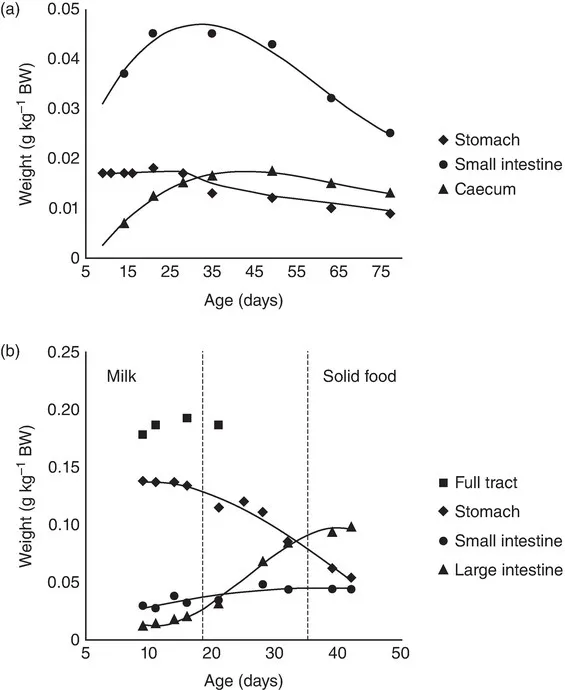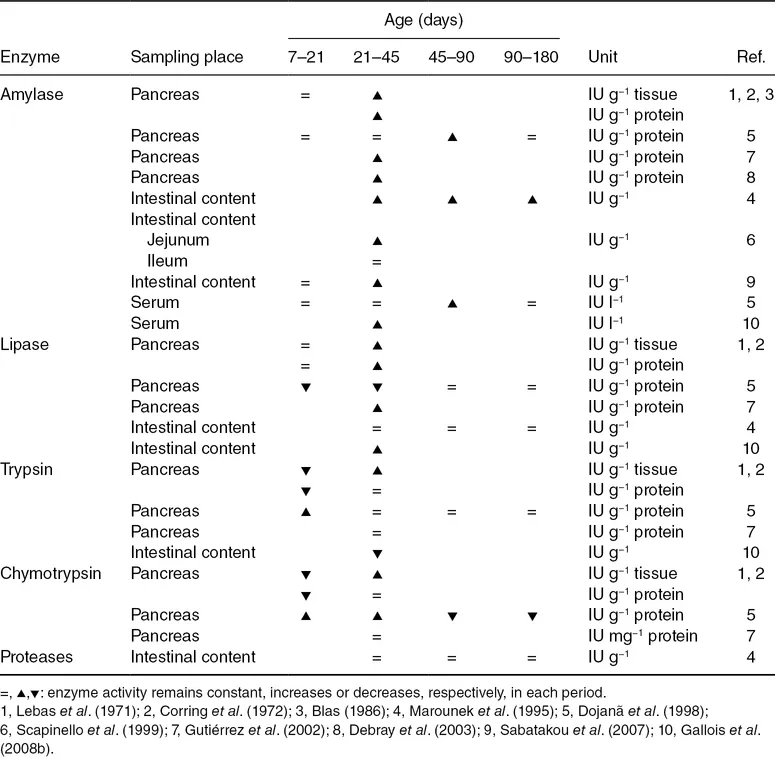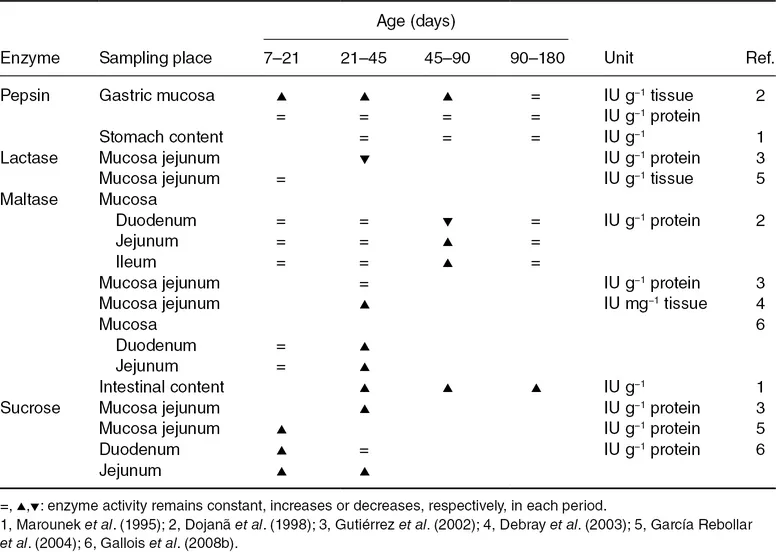
- English
- ePUB (mobile friendly)
- Available on iOS & Android
eBook - ePub
Nutrition of the Rabbit
About this book
Bringing together international expertise in rabbit production, topics covered in this fully updated volume include digestive physiology, feed formulation and product quality, as well as feeding strategies, feed processing, feed management around weaning and the relationship between nutrition and intestinal health. Brand new to this edition, the chapters also discuss the development of immune response and the role of intestinal microbiota, new dietary sources and additives, and feeding behaviour in pasture and organic feeding. A valuable resource for researchers and students of animal nutrition and production, this book provides a comprehensive, research-based review of nutrition for these important animals.
Frequently asked questions
Yes, you can cancel anytime from the Subscription tab in your account settings on the Perlego website. Your subscription will stay active until the end of your current billing period. Learn how to cancel your subscription.
At the moment all of our mobile-responsive ePub books are available to download via the app. Most of our PDFs are also available to download and we're working on making the final remaining ones downloadable now. Learn more here.
Perlego offers two plans: Essential and Complete
- Essential is ideal for learners and professionals who enjoy exploring a wide range of subjects. Access the Essential Library with 800,000+ trusted titles and best-sellers across business, personal growth, and the humanities. Includes unlimited reading time and Standard Read Aloud voice.
- Complete: Perfect for advanced learners and researchers needing full, unrestricted access. Unlock 1.4M+ books across hundreds of subjects, including academic and specialized titles. The Complete Plan also includes advanced features like Premium Read Aloud and Research Assistant.
We are an online textbook subscription service, where you can get access to an entire online library for less than the price of a single book per month. With over 1 million books across 1000+ topics, we’ve got you covered! Learn more here.
Look out for the read-aloud symbol on your next book to see if you can listen to it. The read-aloud tool reads text aloud for you, highlighting the text as it is being read. You can pause it, speed it up and slow it down. Learn more here.
Yes! You can use the Perlego app on both iOS or Android devices to read anytime, anywhere — even offline. Perfect for commutes or when you’re on the go.
Please note we cannot support devices running on iOS 13 and Android 7 or earlier. Learn more about using the app.
Please note we cannot support devices running on iOS 13 and Android 7 or earlier. Learn more about using the app.
Yes, you can access Nutrition of the Rabbit by Carlos de Blas, Julian Wiseman, Carlos de Blas,Julian Wiseman in PDF and/or ePUB format, as well as other popular books in Medicine & Veterinary Medicine. We have over one million books available in our catalogue for you to explore.
Information
1 The Digestive System of the Rabbit
1Departamento de Producción Agraria, Universidad Politécnica de Madrid, Ciudad Universitaria, Madrid, Spain; 2CReSA (UAB-IRTA), Barcelona, Spain

1.1 Introduction
The digestive system of the rabbit is characterized by the relative importance of the caecum and colon when compared with other species (Portsmouth, 1977). As a consequence, the microbial activity of the caecum is of great importance for the processes of digestion and nutrient utilization, but also in the control of digestive pathologies. Furthermore, caecotrophy, the behaviour of ingestion of soft faeces of caecal origin, makes microbial digestion in the caecum more important for the overall utilization of nutrients by the rabbit. Additionally, the rabbit has developed a strategy of high feed intake (65–80 g kg−1 body weight (BW)) and a rapid transit of feed through the digestive system to meet nutritional requirements.
To reach its full functional capacity, the digestive system of the growing rabbit must go through a period of adaptation from milk-based feeding to the sole dependence on solid feed. This adaptation process not only affects the digestion processes, but also microbiota colonization and the development of gut barrier mechanisms that protect the animal against digestive pathologies. This chapter: (i) gives a description of the morphological and functional characteristics of the digestive system of the rabbit that may be important for understanding the digestive processes explained in the following chapters; and (ii) explains how these characteristics change from the critical phase of weaning until attainment of maturity.
1.2 The Digestive System of the Rabbit
The first important compartment of the digestive system of the rabbit is the stomach; this has a very weak muscular layer and is always partially filled. After caecotrophy the fundic region of the stomach acts as a storage cavity for caecotrophes. Thus, the stomach is continuously secreting and the pH is acid. The stomach pH ranges from 1 to 5, depending on site of determination (fundus versus cardiac-pyloric region) (Gutiérrez et al., 2002, 2003; Chamorro et al., 2007; Orengo and Gidenne, 2007; Gómez-Conde et al., 2009), the presence or absence of soft faeces (Griffiths and Davies, 1963), the time from feed intake (Alexander and Chowdhury, 1958) and the age of the rabbit (Grobner, 1982). The lowest figures (from 1 to 2.5) are determined in the cardiac region, in the absence of soft faeces, after 4 h of diet ingestion and in rabbits older than 3 weeks with low presence of milk (Orengo and Gidenne, 2007). The capacity of the stomach is about 0.34 of the total capacity of the digestive system (Portsmouth, 1977). The stomach is linked with a coiled caecum by a small intestine approximately 3 m long, where the secretion of bile, digestive enzymes and buffers occurs. The pH of the small intestine is close to 7 (Vernay and Raynaud, 1975; Nicodemus et al., 2002). The small intestine is the site where the greater part of digestion and absorption take place by passive or active transportation throughout the mucosa. Digestibility at the end of the ileum accounts for 0.8–1 of the total dietary amino acid and starch digestibility (Gutiérrez et al., 2002; García et al., 2005; Carabaño et al., 2009).
The caecum is characterized by a weak muscular layer and contents with a dry matter (DM) of 200 g kg−1. The caecal contents are slightly acid (pH 5.4–6.8) (García et al., 2002). The capacity of the caecum is approximately 0.49 of the total capacity of the digestive tract (Portsmouth, 1977). The colon can be divided in two portions: the proximal colon (approximately 35 cm long) and the distal colon (80–100 cm long). The proximal colon can be further divided into three segments: the first segment possesses three taeniae with haustra between them; the second segment has a single taenia covering half of the circumference of the digestive tube; and the third segment or fusus coli has no taeniae or haustra, but is densely enervated. Thus, it acts as a pacemaker for the colon during the phase of hard faeces formation (Snipes et al., 1982).
Other tissues are also associated with the gut. Gut-associated lymphoid tissue (GALT) and specialized cells (goblet or Paneth cells, responsible for mucus and antimicrobial peptide secretion, respectively) regulate the interaction of the gut mucosa with the microbiota and develop the mechanisms of tolerance and protection against pathogens. The gut barrier function has been reviewed by Forthun-Lamothe and Boullier (2007) and Carabaño et al. (2008).
1.3 Age-related Changes in the Morphology and Function of the Digestive System
The different segments of the digestive system of the rabbit grow at different rates until reaching maturity. The development of the digestive tract begins in the fetal stage; at birth, the stomach and small intestine are the main components of the digestive tract. According to Toofanian and Targowski (1982) and Sabatakou et al. (1999), the stomach glands are evident in late fetuses (26 days’ gestation) and true villi and intestinal glands (crypts of Lieberkühn) are observed at 29 days’ gestation. At birth, however, the intestine of the newborn does not possess all of the mucosal constituents that are present in the adult. These appear in the first week of age (Brunner’s glands in the duodenum) and the adult morphology is not completed until 20 days of age.
The developmental pattern follows a cranio-caudal gradient. The early development of these two segments is important to ensure the survival of the newborn (Fig. 1.1a). From birth to 18–20 days of age, kits drink large amounts of milk during a once-daily nursing, an amount that can reach 0.12 of their BW. This explains the importance of the relative weight of the stomach when its contents are also recorded (Fig. 1.1b). At around 18 days of age, the suckling rabbit begins to eat solid food and decrease its milk intake (see Chapter 13 for more details) and the caecum and colon develop faster than the rest of the digestive tract (Fig. 1.1a). The fast growth of the caecum during this period is more evident if the caecal contents are included (Fig. 1.1b). From 3 to 7 weeks of age, the caecum is filled by digesta and microbiota, and its contents reach a peak of about 0.06 to total BW at 7–9 weeks of age. The pH of the caecum is also affected by age and decreases from 6.8 at 15 days of age to 5.6 at 50 days of age (Padilha et al., 1995).

Fig. 1.1. Development of different segments of the digestive tract of the rabbit (weaned at 35 days) from 9 to 77 days of age: (a) relative weight of empty segments with respect to body weight; (b) relative weight of the segments and their contents with respect to body weight (Lebas and Laplace, 1972; García Rebollar et al., 2004; Gallois et al., 2005). BW, body weight.
The study of the evolution of the functionality of the intestinal mucosa and pancreas is important to understand the ability of the animals (mainly around weaning) to digest substrates other than milk. There has been much effort in the last 10 years to clarify this subject, but some discrepant results remain (Tables 1.1 and 1.2). Differences in the management of animals before sampling (fast or free access to feed, type of diet), the interval of age studied, type of sample analysed (digesta, tissue or serum), place in the intestinal tract (duodenum, jejunum or ileum), time of slaughter (morning or evening), enzymatic methodology (specificity of substrate, time, pH and temperature of the reaction) and unit used to express the activity (IU per mg of protein or mg of tissue or mg digestive content, etc.) may partially explain these discrepancies and make it difficult to give clear conclusions to formulate adequate post-weaning diets.
Table 1.1. Evolution with the age of pancreatic enzymes, according to several authors.

Table 1.2. Evolution with age of gastric and intestinal mucosa, according to several authors.

During the suckling period, the mucosal glands are able to produce enzymes to digest the main components of the milk, while the maturity and functionality of the pancreas are limited when compared with the adult. In this period, gastric lipase represents most of the lipolytic activity of the whole digestive tract, whereas this activity is not detectable in the 3-month-old rabbit (Marounek et al., 1995). Lactase activity is highest until 25 days of age, and sucrase and maltase rise until reaching the adult level at around 28–32 days (Gutiérrez et al., 2002; García Rebollar et al., 2004; Gallois et al., 2008b). The main proteolytic activity is also localized in the stomach of the young rabbit and its importance decreases with age as proteolytic activity in the caecum, colon and pancreas increases (Marounek et al., 1995). There is common agreement that the functionality of the digestive tract is limited from 21 to 42 days of age for amylase and lipase secreted by the pancreas and some enzymes of the gastric or intestinal mucosa; however, protease activity is unclear. These findings are in line with the evolution of the pancreas, which greatly increases in weight when the animals begin to eat solid feed (Lebas et al., 1971), and the development of intestinal morphology (Gallois et al., 2008a). However, this limited enzymatic capacity allows young rabbits (35 days old) to digest 0.9–0.96 of starch by the end of the ileum (Gutiérrez et al., 2002; Gómez-Conde et al., 2007).
Other enzyme activities that increase markedly with the age of the rabbit are those due to the presence of microorganisms that will determine the ability of the rabbit to utilize fibre sources. Cellulase, pectinase, xylanase and urease are some of the main enzymes provided by the intestinal microbiota.
The major age-related changes in the morphologic and functional maturation of the digestive tract seem to be associated with the change from milk to solid food in the feeding pattern of the young rabbit. Furthermore, a higher solid-feed intake in this transition period leads to better growth performance and lower mortality in the growing period (Pascual, 2001). This has increased the interest in studying the effect of an improvement in solid-feed intake by different management techniques such as weaning or modulating the litter size. The effect of age at weaning (from 21 to 35 days) seems to have little influence on the morphology and enzymatic activity in the upper tract (stomach and small intestine) (Corring et al., 1972; Scapinello et al., 1999; Gallois et al., 2005, 2008b). On the other hand, some authors (Gutiérrez et al., 2002; Gómez-Conde et al., 2007) have observed villous atrophy accompanied by...
Table of contents
- Cover
- Half Title
- Title
- Copyright
- Contents
- Contributors
- 1. The Digestive System of the Rabbit
- 2. Digestion of Sugars and Starch
- 3. Protein Digestion
- 4. Fat Digestion
- 5. Fibre Digestion
- 6. Energy and Protein Metabolism and Requirements
- 7. Minerals, Vitamins and Additives
- 8. Feed Evaluation
- 9. Influence of Diet on Rabbit Meat Quality
- 10. Nutrition and Feeding Strategy: Impacts on Health Status
- 11. Feed Manufacturing
- 12. Feed Formulation
- 13. Feeding Behaviour of Rabbits
- 14. Feeding Systems for Intensive Production
- 15. Nutrition and Climatic Environment
- 16. Nutritional Recommendations and Feeding Management of Angora Rabbits
- 17. Pet Rabbit Feeding and Nutrition
- 18. Feeding and Nutrition of Laboratory Rabbits
- Index
- Cabi
- Back